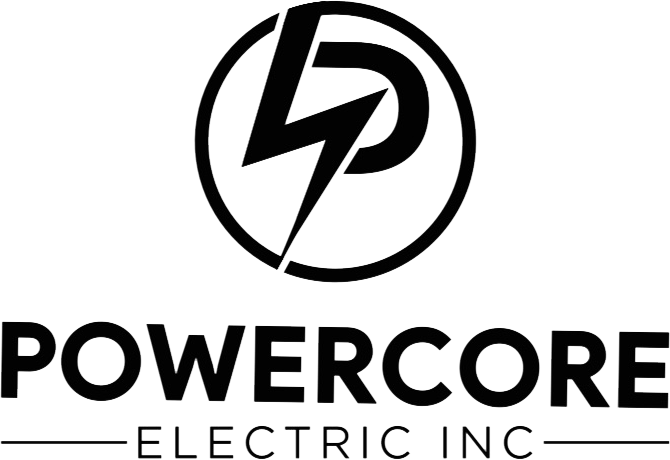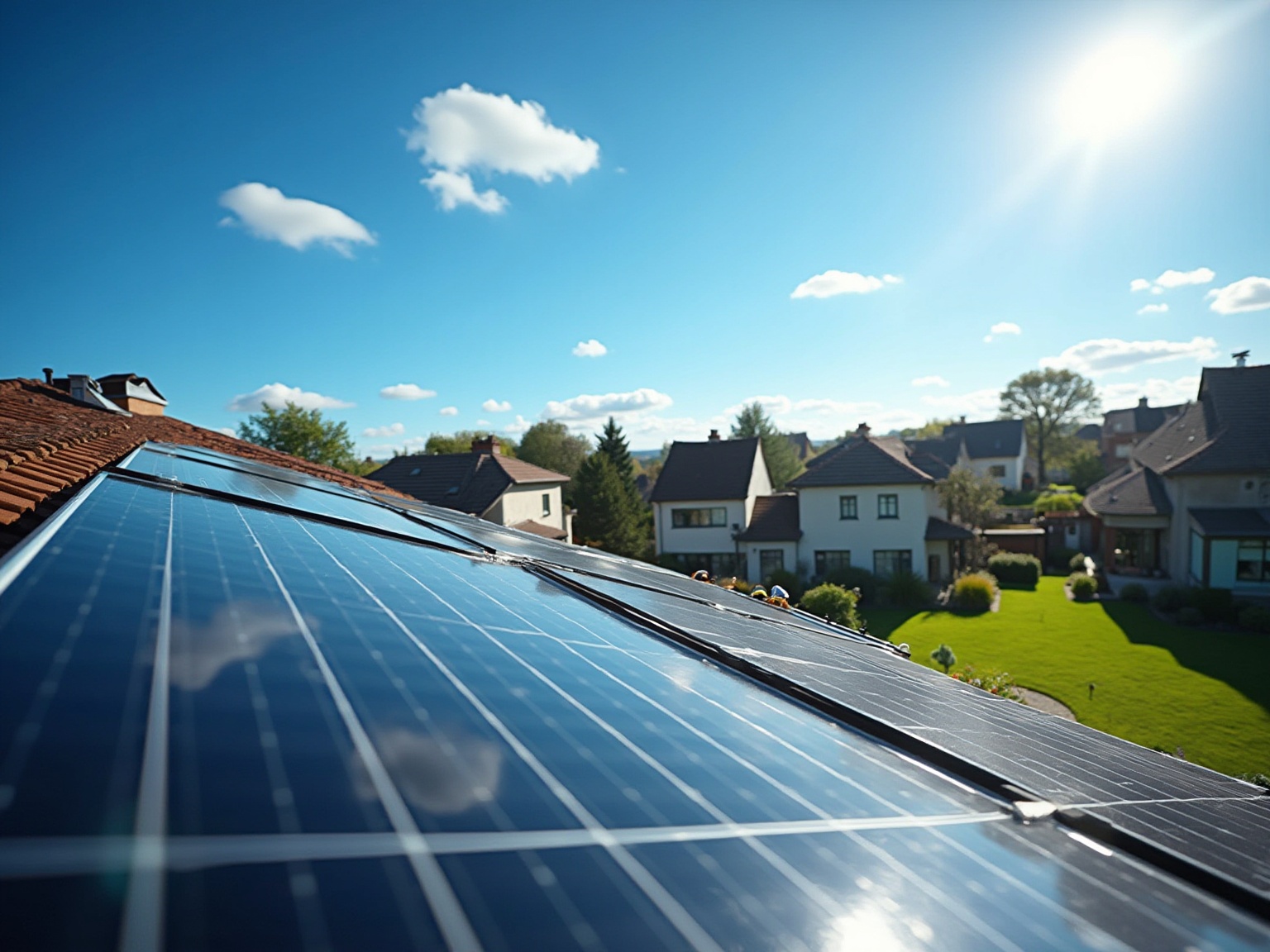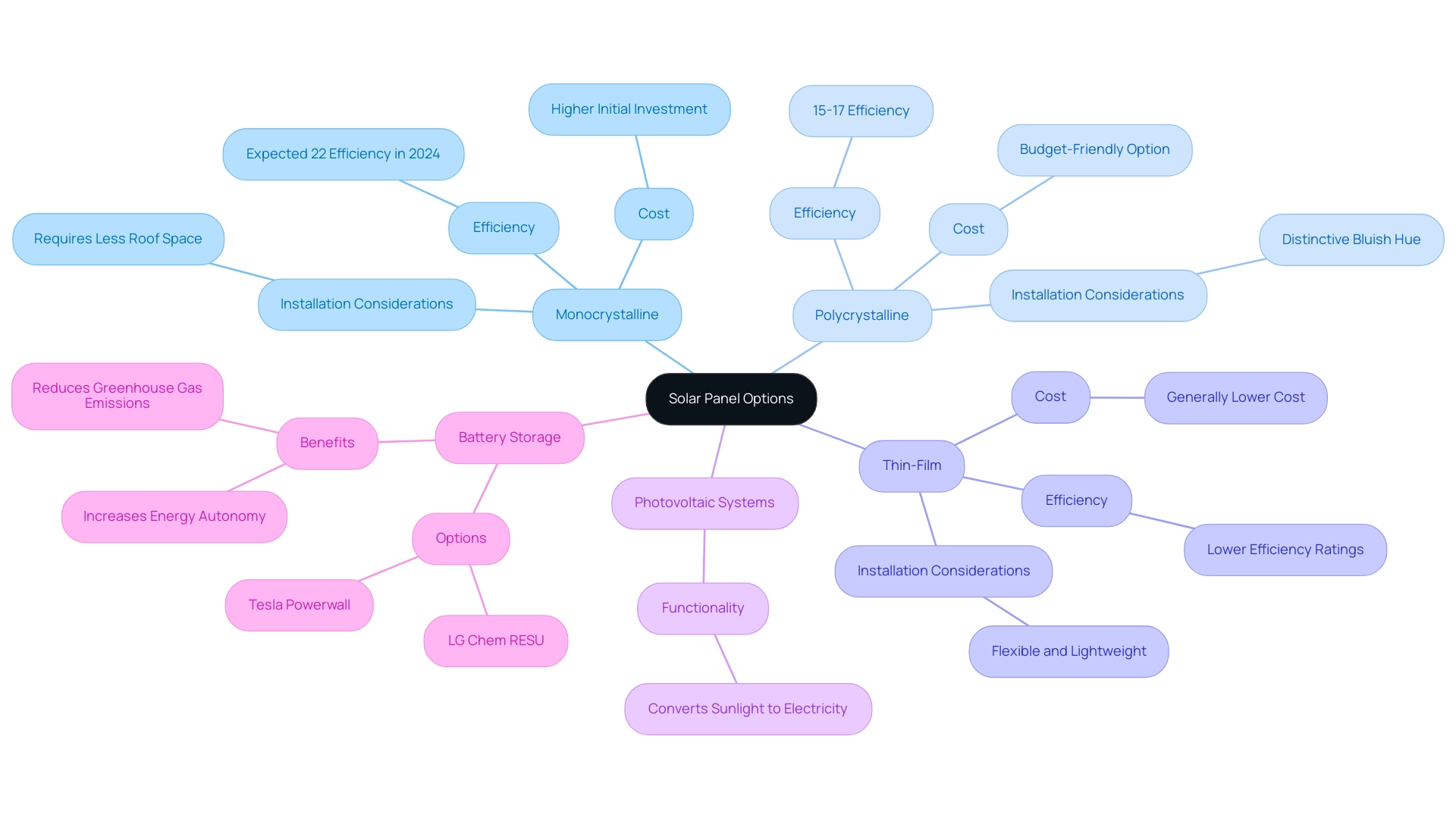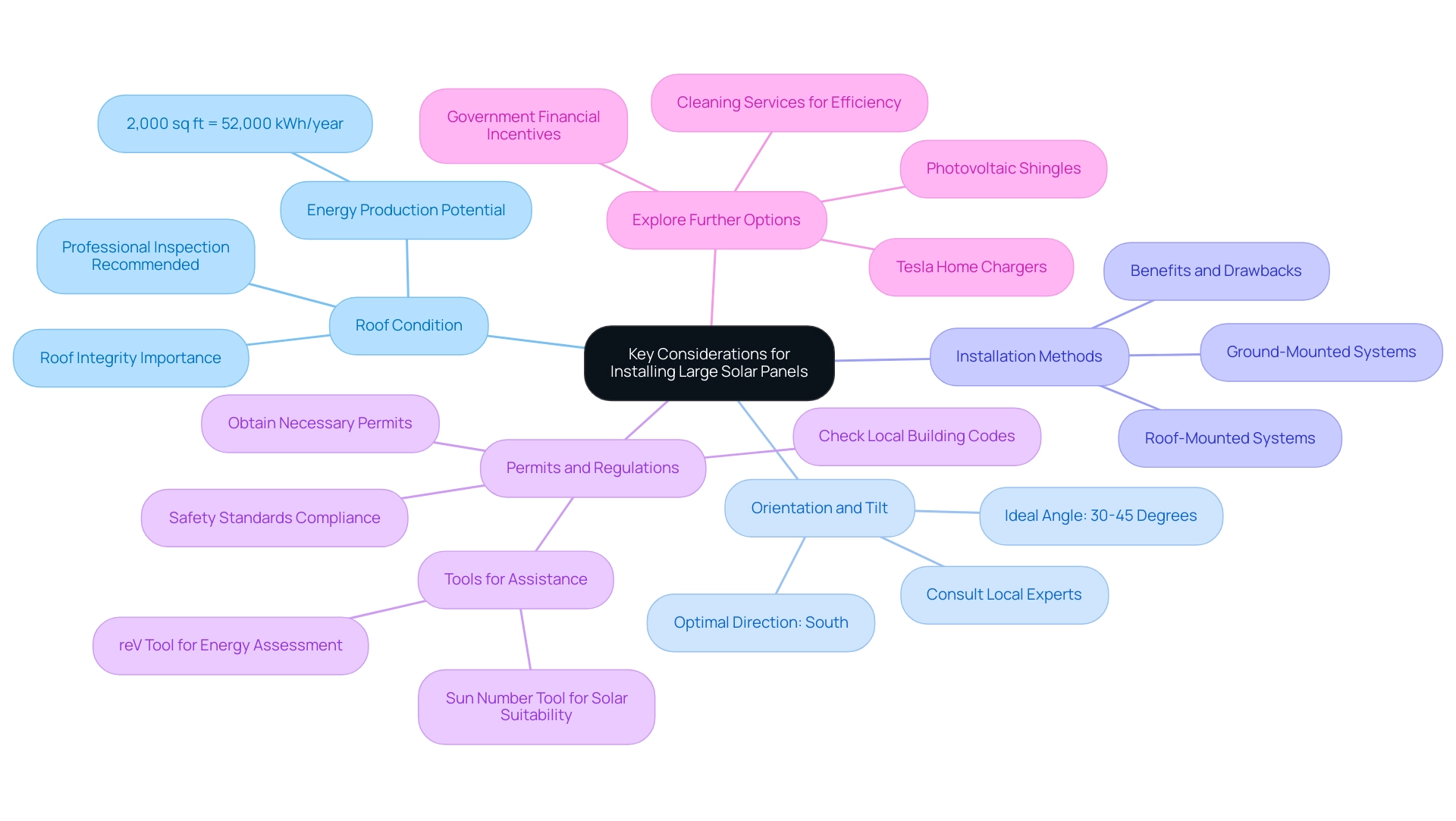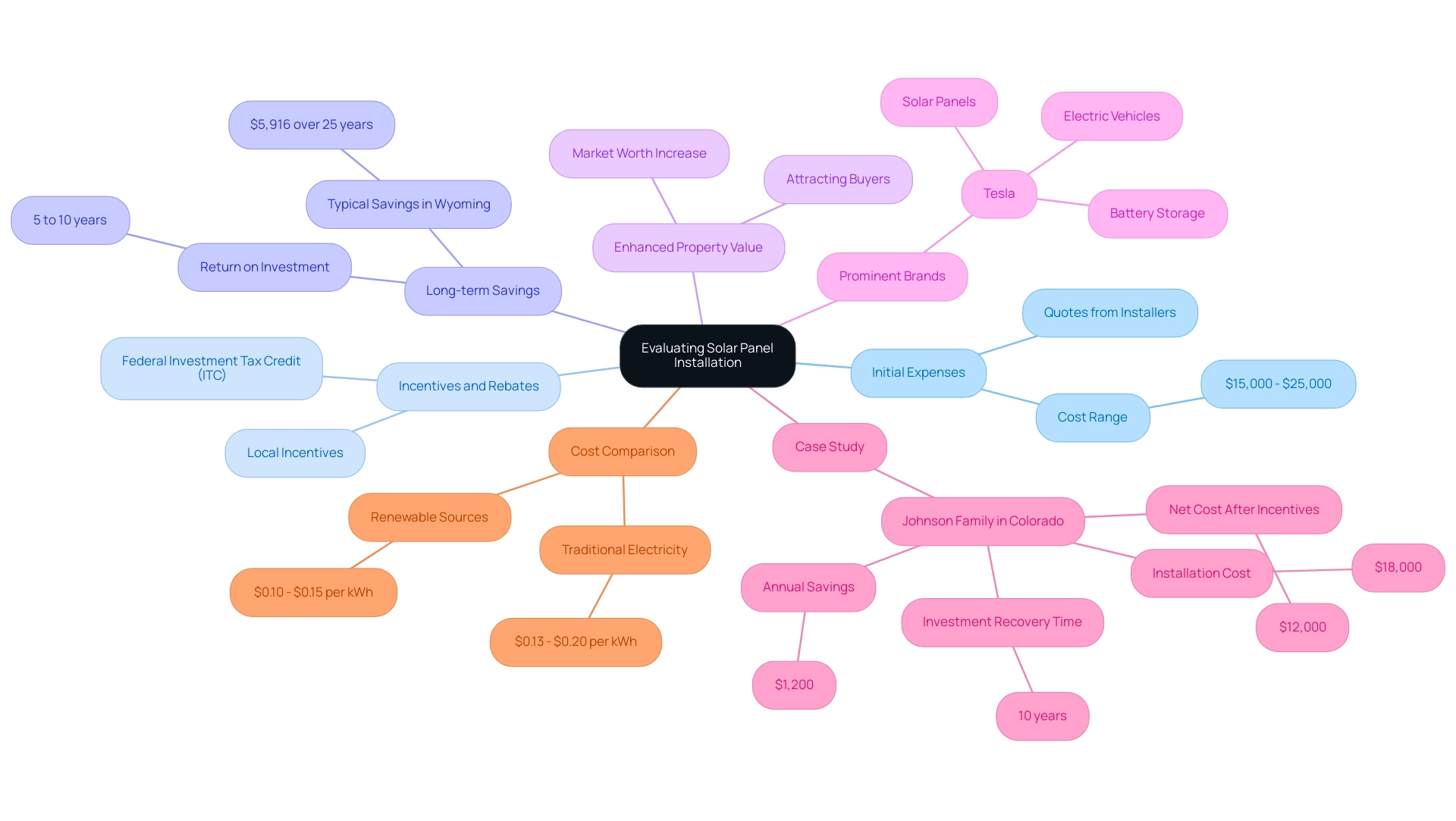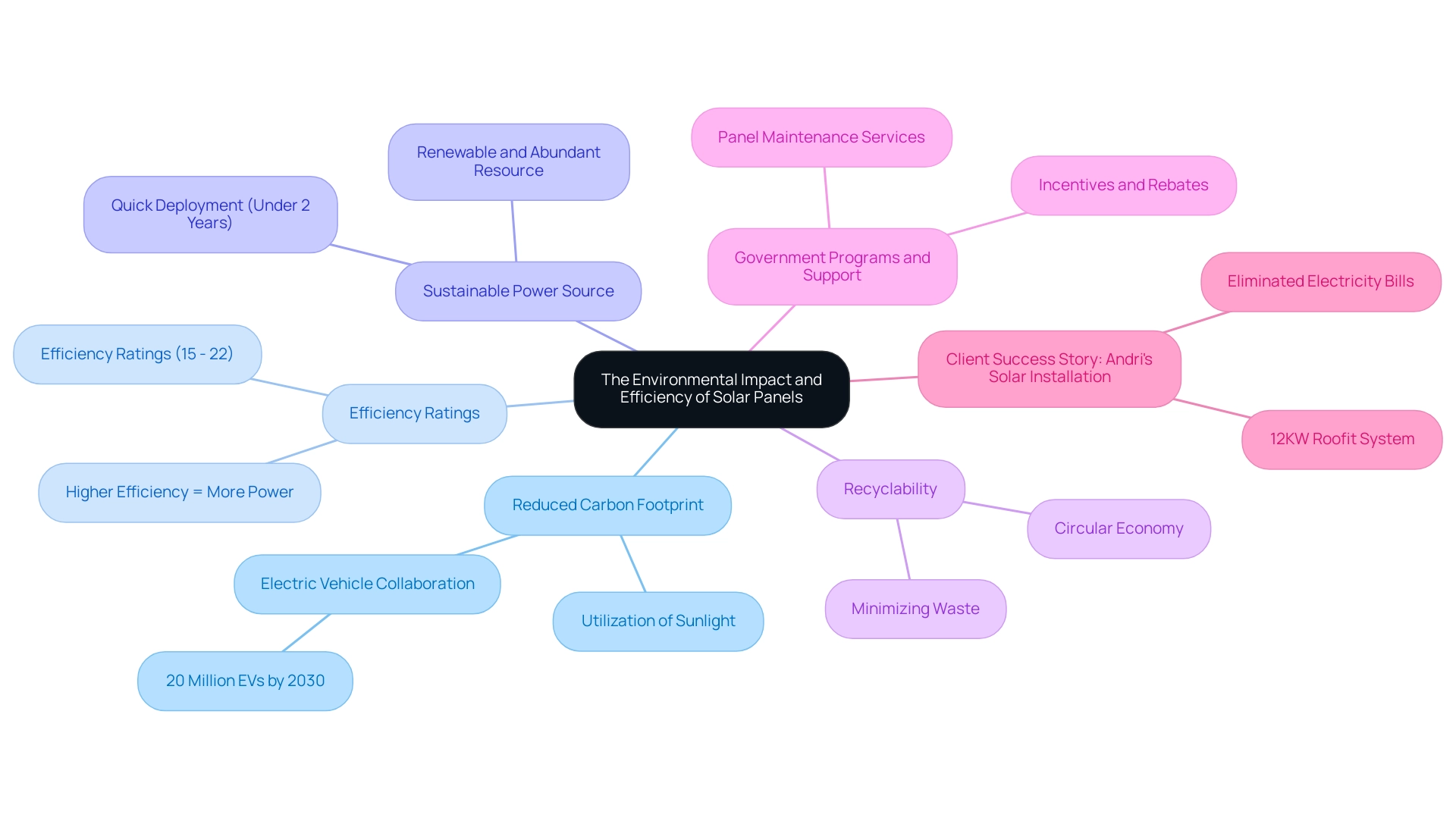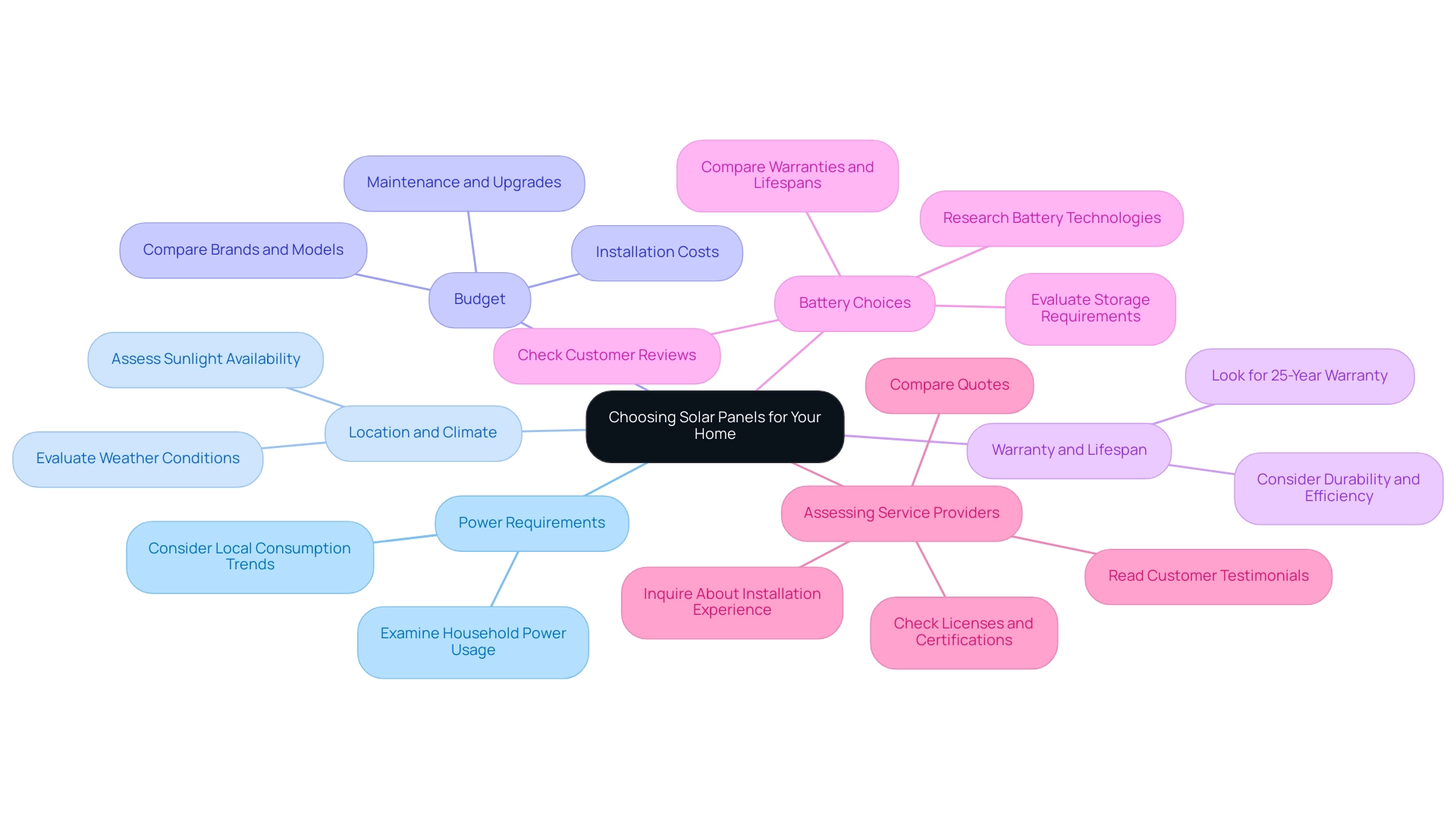Overview:
Choosing and installing large solar panels for your house involves understanding different panel types, evaluating your energy needs, and considering installation factors like roof condition and orientation. The article outlines these aspects by detailing the benefits and drawbacks of various solar panel types, emphasizing the importance of proper installation and maintenance to maximize efficiency and cost savings, ultimately promoting a sustainable energy future.
Introduction
Navigating the world of solar energy can be overwhelming, especially for homeowners eager to make a positive impact on both their wallets and the environment. With a variety of solar panel types available, each with unique benefits and considerations, understanding the nuances can empower homeowners to make informed decisions.
From the sleek efficiency of monocrystalline panels to the budget-friendly polycrystalline options, and even the flexible thin-film alternatives, there’s a solution for every roof and energy need. This guide not only breaks down the types of solar panels and their dimensions but also delves into the installation process, cost implications, and environmental benefits.
By exploring these key elements, homeowners can confidently embark on their solar journey, paving the way for a sustainable future while enjoying the economic advantages that come with harnessing the power of the sun.
Understanding Solar Panel Dimensions and Types
Selecting the appropriate large solar panels for house can seem like a challenging endeavor, but understanding the various options available simplifies the process. Here’s a friendly breakdown:
-
Monocrystalline Modules: These modules are the stars of the show when it comes to efficiency and aesthetics. Made from a single crystal structure, they boast a sleek design and typically require less roof space to generate the same amount of power compared to other types. With advancements in technology, their efficiency ratings are expected to improve even further in 2024, with predictions suggesting an increase of up to 22% efficiency. Notably, major companies like Amazon, Google, and Meta have a combined contracted pipeline of over 25 GW, showcasing the growing demand for high-efficiency solar solutions. Investing in these units not only lowers your utility expenses but also aids in job creation within the renewable energy sector.
-
Polycrystalline Options: If you’re seeking budget-friendly alternatives, polycrystalline options are an excellent choice. Constructed from multiple crystal structures, they tend to be less efficient than their monocrystalline counterparts but come at a lower price point. You can easily identify large solar panels for house by their distinctive bluish hue and speckled appearance. Recent performance studies show they still deliver solid results for many homeowners, with efficiency ratings around 15-17%. However, it’s important to consider that the depletion of the California queue and higher financing costs have negatively impacted the installation of large solar panels for house, leading to the lowest quarter for new installations since 2021. Selecting these modules aids in fostering sustainability by decreasing dependence on fossil fuels.
-
Thin-Film Modules: Lightweight and flexible, thin-film modules provide versatility in installation. They can fit in tight or unconventional spaces, but they usually have lower efficiency ratings, meaning you may need more of them to match the output of other types. If you’re contemplating this alternative, remember their criteria for larger spaces to produce comparable power. Additionally, by adopting photovoltaic technology, you support clean power initiatives that improve fair access to renewable resources for all communities.
How Photovoltaic Systems Function
Photovoltaic systems transform sunlight into electricity through photovoltaic cells. When sunlight hits these cells, it excites electrons, generating direct current (DC) electricity. An inverter then converts this DC electricity into alternating current (AC) electricity, which powers your home.
Grasping this procedure is essential for enhancing your autonomy and effectiveness.
Optimal Battery Selections for Effective Power Storage
To supplement your photovoltaic system, think about incorporating a battery for power storage. Options like the Tesla Powerwall or LG Chem RESU provide dependable solutions, enabling you to store surplus power generated during the day for use at night or on overcast days. This not only boosts your energy autonomy but also aids in decreasing greenhouse gas emissions by optimizing the use of renewable energy.
By comprehending these varieties and their typical sizes, along with how photovoltaic systems function and the ideal battery options, you can make a knowledgeable decision regarding the installation of large solar panels for house that best suits your roof space and energy requirements. This knowledge not only empowers you as a homeowner but also contributes to a greener future, helping to reduce greenhouse gas emissions and promoting a sustainable lifestyle!
Key Considerations for Installing Large Solar Panels
Before you dive into the exciting realm of renewable energy installation, there are several key considerations to keep in mind:
- Roof Condition: First and foremost, ensure your roof is in great shape and can handle the weight of those energy collectors. It’s wise to have a professional inspect your roof to catch any potential issues before installation. As Sara Wolf indicates,
In brief, yes, you can install photovoltaic systems on a metal roof, but the state of your roof is vital for a successful installation. Remember, for a roof size of 2,000 square feet, the approximate total yearly power generation can reach up to 52,000 kWh, making roof integrity even more critical. - Orientation and Tilt: For optimal sun exposure, large solar panels for house should ideally face south and be inclined at an angle between 30 to 45 degrees. However, this can vary based on your geographical location, so consider consulting a local expert for tailored advice.
- Installation Methods: Familiarize yourself with the different installation methods available, such as roof-mounted or ground-mounted systems. Each method for installing large solar panels for house has its own benefits and drawbacks, depending on your property layout and local guidelines. Understanding these options is essential for making an informed decision.
- Permits and Regulations: Lastly, don’t forget to check your local building codes and regulations before you get started. It’s essential to ensure compliance, which may include obtaining permits and adhering to safety standards. Tools like reV can assist you in comprehending the renewable resources options available based on your specific location and needs. Furthermore, think about utilizing the Sun Number Tool, which offers a numerical value indicating the suitability of your rooftop for sunlight, assisting you in evaluating the potential for renewable power generation.
- Explore Further Options: As a Long Beach renter, don’t disregard the possibilities of Tesla home chargers and photovoltaic shingles, which can be incorporated into your power solutions. Explore government initiatives that may provide financial incentives, and think about cleaning services that preserve your energy collection systems for optimal efficiency.
By keeping these factors in mind, you’ll be well on your way to harnessing the sun’s power effectively and efficiently while enjoying the economic and environmental advantages that accompany energy heating systems—whether active or passive. It’s all about energy efficiency integration and long-term sustainability!
Evaluating the Costs and Benefits of Solar Panel Installation
When assessing the expenses and advantages of photovoltaic system installation, it’s crucial to examine several key factors to make a knowledgeable choice:
- Initial Expenses: The average cost for photovoltaic system installation generally falls between $15,000 and $25,000, depending on the size and kind of system you select. To ensure you’re getting the best value, remember to gather quotes from multiple installers.
- Incentives and Rebates: Don’t overlook local and federal incentives that can significantly reduce those upfront costs. Programs such as the Federal Investment Tax Credit (ITC) offer significant savings, making renewable energy more accessible than ever.
- Long-term Savings: One major advantage of installing large solar panels for house use is the potential for long-term savings on your electricity bills. Numerous property owners observe a return on their investment within 5 to 10 years, affected by consumption and local rates. Significantly, with recent rises in grid electricity prices, transitioning to photovoltaic systems is demonstrating to be a dependable method to reduce essential utility expenses. For example, the typical 25-year savings from photovoltaic systems in Wyoming is approximately $5,916, highlighting the financial advantages of this investment.
- Enhanced Property Value: In addition to immediate savings, installing photovoltaic units can increase your property’s market worth. If you intend to sell later, this investment not only yields savings in power but can also draw purchasers interested in efficient residences. As the market develops, the decreasing expense of photovoltaic systems, particularly large solar panels for house, combined with the recent surge in grid electricity prices, have made residential renewable energy a wise option for lowering essential power costs.
- Prominent Brands: Furthermore, looking at well-known companies like Tesla can offer valuable insights into the market. Tesla is acknowledged for its photovoltaic panels, battery storage, and electric vehicles, and understanding their offerings and pricing reflects the increasing demand for renewable solutions among eco-conscious homeowners.
- Case Study: For example, the Johnson family in Colorado installed large solar panels for house use that cost approximately $18,000. With the help of local incentives, their net cost was reduced to $12,000. They now save approximately $1,200 each year on their electricity bills, indicating they will recover their investment in just 10 years, greatly enhancing their property’s value in the process.
- Cost Comparison: When comparing renewable power costs to conventional electricity, homeowners can expect to pay around $0.10 to $0.15 per kilowatt-hour for renewable sources, while traditional electricity rates can average around $0.13 to $0.20 per kilowatt-hour, depending on the region. This cost-effectiveness further highlights the financial benefits of shifting to renewable sources.
The Environmental Impact and Efficiency of Solar Panels
Large solar panels for house offer more than merely a method to reduce your electricity costs; they represent an essential advancement towards a more sustainable future, particularly for Long Beach renters seeking eco-friendly solutions. Here’s why transitioning to renewable sources is not only a wise financial choice but also a significant contribution to the environment:
-
Guide to Reduced Carbon Footprint: By utilizing sunlight, you can dramatically decrease your dependence on fossil fuels. This shift leads to significant reductions in greenhouse gas emissions, helping combat climate change. Recent studies indicate that switching to renewable energy can significantly decrease your carbon footprint, making it a meaningful option for environmentally aware homeowners. With the number of electric vehicles expected to reach 20 million by 2030, the collaboration between renewable sources and EV adoption becomes increasingly essential, as homeowners can power their vehicles with clean resources from photovoltaic chargers, such as those from Tesla.
-
Efficiency Ratings: When choosing photovoltaic modules, efficiency is key. Most photovoltaic panels boast efficiency ratings between 15% and 22%, with higher-rated panels converting more sunlight into usable power. This signifies greater power for your home, and it’s crucial to consider these ratings during your selection process for large solar panels for house to maximize your investment and ensure long-term sustainability.
-
Sustainable Power Source: Large solar panels for house provide a renewable and abundant resource, making them an ideal solution for homeowners dedicated to environmental stewardship. By transitioning to renewable sources like large solar panels for house installations, you’re not just lowering your expenses; you’re also promoting a sustainable power future. Significantly, photovoltaic and onshore wind farms generally require under two years to build, whereas gas-fired power stations may need up to four years to be operational, emphasizing the effectiveness of such energy deployment.
-
Recyclability: A fantastic attribute of many photovoltaic systems is their recyclability. As the energy sector expands, so does the commitment to sustainability, promoting a circular economy that minimizes waste. This signifies that when your systems reach the end of their lifespan, many parts can be recycled, further minimizing your environmental effect.
-
Government Programs and Support: Long Beach renters can benefit from various government initiatives that provide incentives and rebates for renewable energy installation. Furthermore, cleaning services that focus on panel maintenance can help ensure optimal performance and longevity of your system.
Consider the success story of Andri, who installed large solar panels for house with a 12KW Roofit system that completely eliminated his electricity bills. This not only showcases the financial advantages of adopting renewable sources but also illustrates the positive environmental impact of such a choice, reinforcing the notion that these alternatives are a win-win for both your wallet and the planet. Furthermore, with the increase of solar-powered electric vehicle charging stations in Los Angeles, the advantages of renewable sources extend beyond private residences, showcasing the wide attraction and relevance of these solutions in diverse sectors.
Moreover, property owners should investigate Tesla charging stations and battery choices to improve their renewable power systems, ensuring they possess the best technology accessible to optimize their savings.
Choosing the Right Solar Panels for Your Home
Selecting the ideal photovoltaic modules for your residence entails several important factors that can significantly impact the optimization of your investment:
-
Power Requirements: Begin by examining your household’s power usage closely. Comprehending how much power you consume will assist you in deciding the appropriate size and quantity of large solar panels for house needed for optimal power generation. This evaluation is essential, particularly as average household power usage differs significantly across areas. For context, Wyoming’s yearly natural gas usage per person is 14 trillion Btu, emphasizing the necessity of assessing power requirements according to local consumption trends.
-
Location and Climate: Your geographical position significantly influences panel efficiency. Regions that enjoy abundant sunlight will naturally gain more from renewable resources, including the use of large solar panels for house installations, compared to areas that experience frequent clouds or severe weather conditions. For instance, residences that utilize large solar panels for house in bright areas can anticipate improved performance and savings. The case study on power prices indicates that geographic and infrastructural factors significantly influence costs, which supports the discussion on how location affects photovoltaic efficiency.
-
Budget: Establishing a budget is essential, and it should encompass not just the installation expenses but also maintenance and potential upgrades down the line. It’s prudent to evaluate different brands and models of large solar panels for house to identify the most appropriate choice for your financial situation, guaranteeing you receive the best value without sacrificing quality.
-
Warranty and Lifespan: Seek systems for large solar panels for house that include a robust warranty, usually lasting around 25 years. This assurance is key to ensuring your investment remains reliable and productive over time. The longevity of the panels adds to their overall worth, making it worthwhile to consider those that guarantee durability and efficiency.
-
Battery Choices: Don’t underestimate the significance of choosing the appropriate battery for effective power storage. A high-quality battery system will assist you in optimizing your investment with large solar panels for house by enabling you to store surplus power for use during overcast days or at night, guaranteeing a steady power supply. To assess battery options, consider the following steps:
- Evaluate your storage requirements based on your usage patterns;
- Research different battery technologies (like lithium-ion vs. lead-acid);
- Compare warranties and lifespans;
-
Look for customer reviews and performance data.
-
Assessing Service Providers: As you navigate your renewable journey, it’s essential to evaluate various service providers. Look for those who offer transparent pricing, robust customer service, and comprehensive warranties. Here’s a checklist to help you evaluate service providers:
- Check for licenses and certifications;
- Compare quotes from multiple companies;
- Read customer testimonials and case studies;
- Inquire about their experience with installations similar to yours.
A comprehensive competitor analysis can assist you in discovering the best value in renewable solutions customized to your requirements.
By considering these aspects, you can make a more informed choice that aligns with your power needs and lifestyle. Furthermore, keep in mind that individual freezers typically require about $74 annually to run, which can act as a benchmark when evaluating possible savings from renewable sources. Exploring different solar solutions, including the comparison between large solar panels for house and solar roofs, as well as considering the installation of home EV charging stations, can further enhance your energy efficiency and eco-friendliness.
Conclusion
Understanding the diverse landscape of solar energy options is essential for homeowners eager to embrace sustainability while enjoying economic benefits. The journey begins by recognizing the different types of solar panels—monocrystalline, polycrystalline, and thin-film—each with its unique advantages and considerations that cater to various needs and budgets. By selecting the right type, homeowners can optimize their energy production, ensuring they harness the sun’s power effectively.
Installation considerations play a crucial role in the success of solar energy systems. Factors such as:
– Roof condition
– Orientation
– Local regulations
must be carefully evaluated to ensure a seamless installation process. Additionally, understanding the potential costs and long-term savings associated with solar panel installation can help homeowners make informed financial decisions, ultimately leading to energy independence and increased home value.
The environmental impact of switching to solar is profound, contributing to reduced carbon footprints and promoting a sustainable future. With the added benefits of energy storage solutions, homeowners can maximize their solar investment while supporting green initiatives. By taking these steps, homeowners not only invest in their financial well-being but also join the movement towards a cleaner, more sustainable planet.
Now is the perfect time to explore solar energy options. With advancements in technology and supportive government programs, transitioning to solar has never been more accessible or beneficial. Embracing solar energy is a powerful way to take control of energy needs, enhance property value, and contribute positively to the environment—making it a win-win for both homeowners and the planet.
